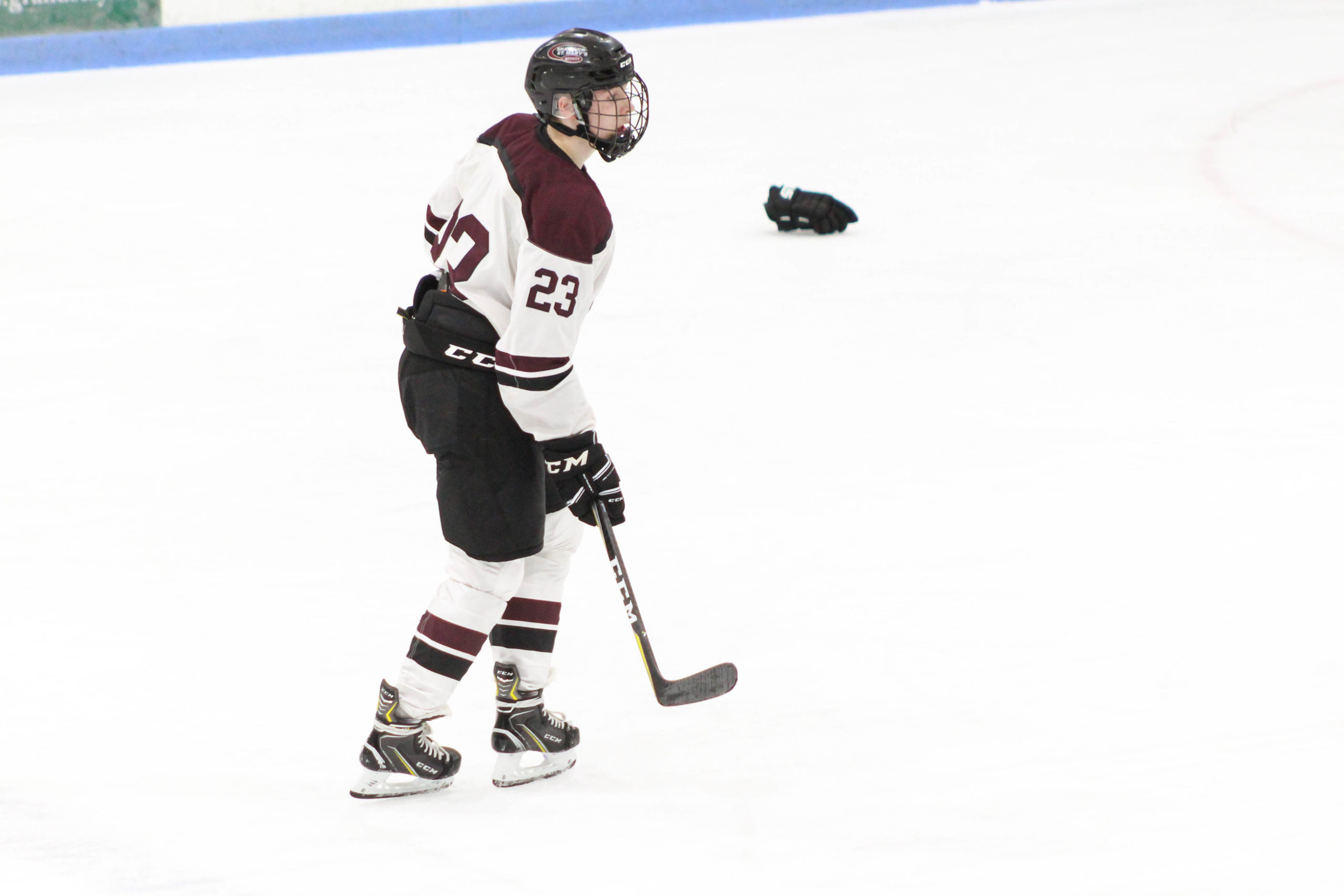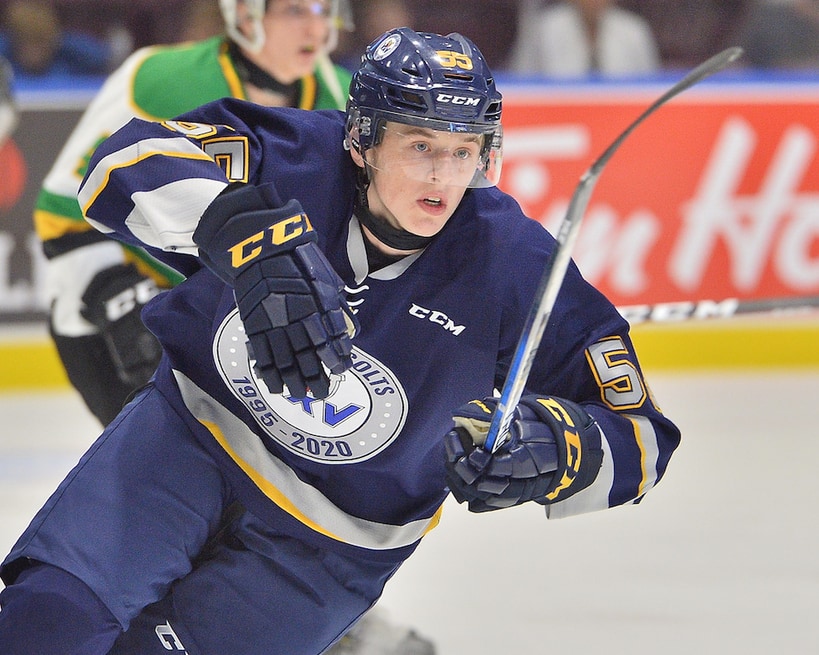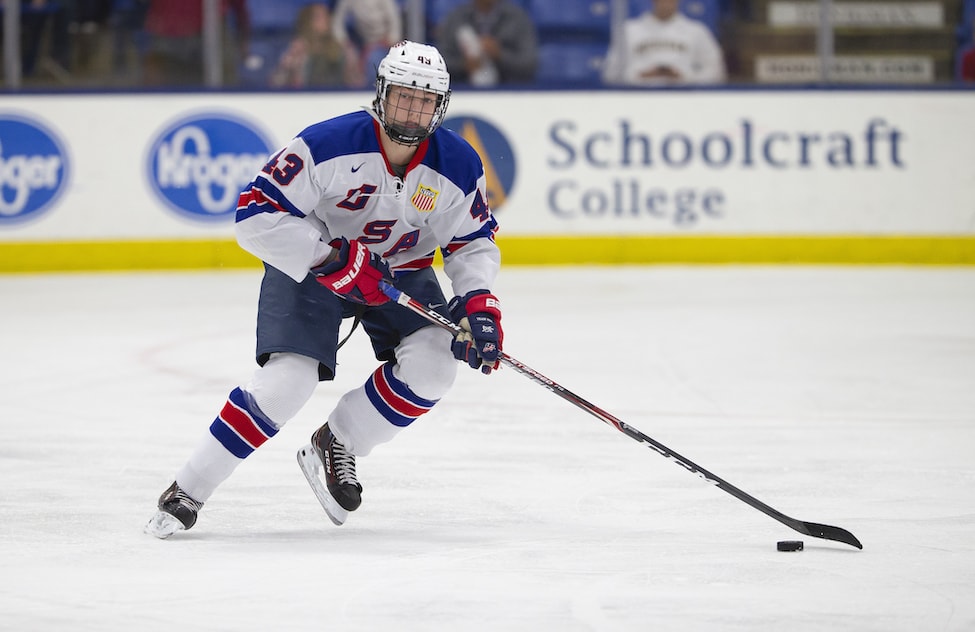Welcome back to another edition of the 2021 NHL Draft’s top five, where we compare this year’s draft eligibles and their individual abilities.
The previous three rankings were focused on forwards – we compared the best playmakers, the most competent goalscorers and the top two-way forwards in this draft. However, the sheer quantity of defensemen projected in the first two rounds warrants a deeper look at the blueliners who display the foundational aspects of most modern-day NHL defenses: transitional play and puck-moving ability.
5. Brent Johnson, RHD – Sioux Falls Stampede, USHL
The Stampede’s program is currently being overshadowed by the amount of draft-eligible talent playing for the Chicago Steel and the United States National Team Development Program (USNTDP), but Johnson’s play so far warrants an appearance on this lineup. He has accumulated 32 points in 47 United States Hockey League (USHL) games so far, resulting from his great skating and offensive abilities.
Related: 2021 NHL Draft Guide
His swiftness on turns and his ability to get rid of forecheckers with ease when carrying the puck allow him to play positive hockey, constantly looking to play the puck into dangerous ice. His vision and puck distribution make him a threat on breakouts and entries, and he has the mind to find pockets of space as a trailing defenseman off the rush. His wrist shot is heavy and unpredictable, often slipping past goaltenders as they misjudge its trajectory and force. His feature asset, however, is a slick pair of hands:
Johnson’s main issues will be putting weight on his 5-foot-11 frame and learning to outsmart forwards when defending in-zone. However, his ability to simply create something out of nothing should continue to be a staple of his offensive game heading forward. Peter Baracchini had him 98th out of 100 ranked players for the upcoming 2021 NHL Draft, but his name is showing up higher and higher on draft boards, with USHL scouts like FC Hockey’s Dylan Krill placing him in the 33-40 range of the draft.
You can find more info on Brent Johnson in my DobberProspects USHL deep dive, in which I look at the footage and break down his underlying numbers.
4. Simon Edvinsson, LHD – Frölunda HC, SHL
The Swedish Hockey League (SHL) and its affiliated programs have been churning out NHL prospects like never before, as more and more Swedish players are being picked in the top three rounds. Frölunda has been especially proficient in producing quality defensive prospects in recent years, with Rasmus Dahlin and Mattias Norlinder being their most notable recent blue line development projects.

Edvinsson fits the Frölunda mold to a T as a smooth-skating defenseman with a penchant for breakout passes and line carries. His skating is among the most technically sound of the 2021 NHL Draft, as he shows good posture when performing crossovers and wastes very little energy with his strides. His turns need tightening up, but his level of hustle often overturns that issue.
At 6-foot-5, 207 pounds already, and with his skating abilities, he has drawn comparisons in style to Victor Hedman. However, Hedman showed much more impressive defensive decision-making and poise in his draft year, warranting a second overall pick in 2009. If Edvinsson can work on staying calm on the puck and making sound decisions, which are currently very valid concerns with his game, he could hope to become as dominant and complete a defenseman as Hedman is. Zator’s top 100 of April has him in the 11th overall slot. Still, he could definitely see his name in the top 10, especially with the Detroit Red Wings going up on the board in that range – they love their Swedes and would especially be inclined to give him a chance if other notable Swedish prospects Eklund and Lysell are off the table by their pick.
3. Scott Morrow, RHD – Shattuck St. Mary’s, USHS
Evaluating Morrow from a scouting standpoint is currently extremely difficult, as he has been playing high school prep hockey at the Shattuck St. Mary’s program in Minnesota. As a result of his weaker competition, it is difficult to get a full scope of what he is capable of. However, when he carries the puck up the ice, dangles through defenders with ease, and slings tape-to-tape passes for clean zone entries, and when he produces as he does currently, you can see the outline of a top-pairing, powerplay quarterback in Morrow.

His ability to spot open space, find the best way to exploit it, and execute at high speeds is admirable; he reads the play well, and his ability to understand seams allows him to both attack and defend with much less effort. Morrow will often jump up on the play, cutting off a stretch pass or stripping the puck from the carrier himself. He could benefit from slowing down on occasions, which he should learn with experience. Sometimes the best play is a second’s hesitation away, and Morrow will often try to precipitate the play instead of letting it develop organically.
Morrow’s 33 points in 24 games are the highest points-per-game average of his entire team – including all 12 forwards – and although there is no way of telling how that production will translate at higher levels, he has shown that he belongs on this list. Morrow’s performance with the University of North Dakota next year will be much more telling of his projectability, as the NCAA’s level of opposition will offer him the challenge he needs. Matthew Zator has him at 25th in his Top 100 of April, and he could keep climbing up until the draft.
2. Brandt Clarke, RHD – Barrie Colts, OHL / HC Nove Zamky, Slovakia
Clarke’s 2021 season is yet another story of COVID-related relocation, as the Ontario Hockey League (OHL) shut its doors for the entire season. He went on loan to Nove Zamky in the Slovak top division to join his brother, Devils prospect Graeme Clarke. He was off to a cold start but has finished his season with 15 points in 26 games. His ability to beat attackers when closing down on the slot from the blue line is fun to watch, as he disposes of sticks and bodies with little effort while carrying the puck.

Clarke’s 6-foot-1 frame hides a sturdy, competitive demeanor, which is on display when he is protecting the puck. His skating is elite, his passing is above-average, and he has shown the ability to solve problems in the offensive zone like few in this draft class can. He will need to improve his rush defense and stick positioning in-zone, but he has shown this year that he can play against men and do it well.
Clarke is a possible top-five pick this year, as the lowest he is rated is seventh among the most notable draft coverage websites. Zator has him sixth in his April rankings as the third-best defenseman available. He will either continue growing his game in Slovakia next year, or return to the OHL when they reopen the league.
1. Luke Hughes, LHD – USNTDP, USHL
Hughes will likely follow in the footsteps of brothers Jack and Quinn, who were both top-seven picks in their respective drafts. Having grown up in the same environment as his brothers, Luke’s skating is just as fluid. He shows a tiny bit of knee flare in his stride, but that is likely a byproduct of being 6-foot-2 and not having much leg muscle from which to employ force. As he matures physically, Hughes will show more than he already has that he is a gifted skater.

He is a product of the USNTDP, for which he leads his defensemen in USHL points per game, with 15 in 18 starts for the Program. His edgework plays a massive part in his ability to score points, as he regularly dictates play himself by carrying the puck into dangerous areas and evades pressure by walking the blue line effortlessly. His poise in the front half of the rink allows him to find teammates in open spots regularly, and he does not hesitate to jump into the rush.
Hughes’ stickhandling is another impressive asset of his, as he can dangle around pressure with ease, using his skating to his advantage and keeping the puck away from opposing sticks in transition. His shot needs a lot of work, as he seems to put minimal force into it. His upper body seems strong on puck protection and board battles, so the issue is likely either technical, mental, or a mix of both. His poise in his own zone does falter at times, leading to the occasional avoidable turnover.
Hughes is committed to Michigan University next season, a team that is growing more and more unstoppable with every addition. Three of the top-10 players on Zator’s top 100 currently play on that program and likely will next year as well; good company for a defenseman looking to work with skilled teammates and show what he has to offer. Hughes is only behind Matt Beniers in Zator’s ranking among the Michigan prospects, sitting at fourth overall – the highest-rated defenseman of the draft.
Do you agree with my top-5? Who would you replace with who? Let me know in the comments below!